Anytime we see a cute furball hanging out at the park or taking a walk, it’s hard to resist the urge to stop, say hello, and even give them the good old petting.
For us humans, petting is a way to let these cuties know that we like them so much we can’t keep our hands to ourselves.
But dogs speak a different language, which means they may not like petting at all.
Dogs may not let strangers pet them because of fear, often due to poor socialization, a history of abuse, or simply not being comfortable with an unfamiliar person. Moreover, you should not let strangers pet your dog if they are reactive and aggressive or you’re unsure how strangers will handle it.
Other things play into whether or not a dog will allow strangers to come into their personal space, such as their temperament, where they’re at in their training, and even what they’re doing at the moment.
Let’s learn more about how to get your dog to accept strangers, as well as reasons why dogs prefer strangers to keep their distance.
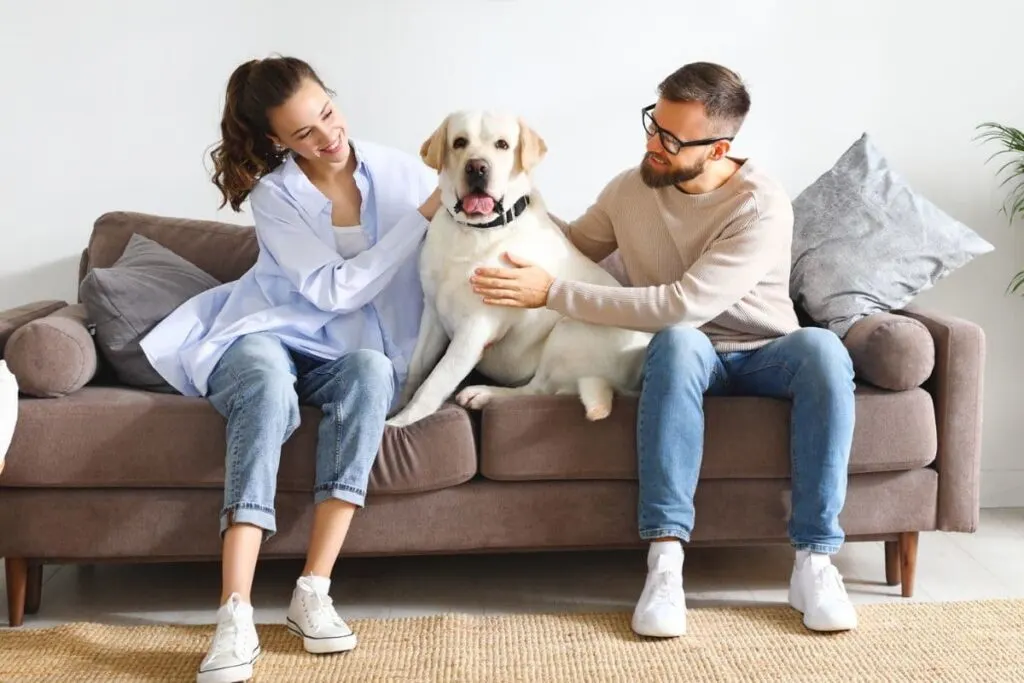
Click Here to Jump to a Section
How Do I Get My Dog to Accept Strangers?
Dogs are such great pets because of their playfulness, loyalty, and intelligence.
They’re also so cute that many dog owners can’t resist treating their furballs as babies or rowdy little children!
But no matter how cute and child-like they are, dogs operate on a completely different level than humans do.
They are complex animals that have a different way of communicating with the world, including us humans.
In fact, except for some that have grown used to it from a very young age or are naturally accepting of it due to their temperament, dogs have an innate dislike of being petted—even though they may tolerate it.
Petting on the head and even hugging can come through to dogs as dominating behavior, and most of them do not appreciate it, especially from a total stranger.
Thankfully, though, dogs are extremely trainable animals because not only are they intelligent, but they are also usually quite eager to please their humans, so you can train your dog to accept strangers.
Here’s how you can do it:
Understand Your Dog’s Temperament
Before trying to make your dog accept any visitor, whether in the controlled environment of your home or in a much larger space such as a dog park, make sure that you understand your dog’s temperament well enough.
There are three main types of dog temperament:
- Assertive. These dogs are the leader of the pack, and they like to assert themselves as the top dog whatever the situation—sometimes even with their owners!
- Neutral. These dogs are the easiest to work with because they are calm, go-with-the-flow, and very playful, which means they will often respond well even to strangers.
- Passive: Passive dogs are easier to work with than assertive ones, but they will require a bit of a nudge, as they prefer to be left alone to do their thing without other people or dogs disturbing them.
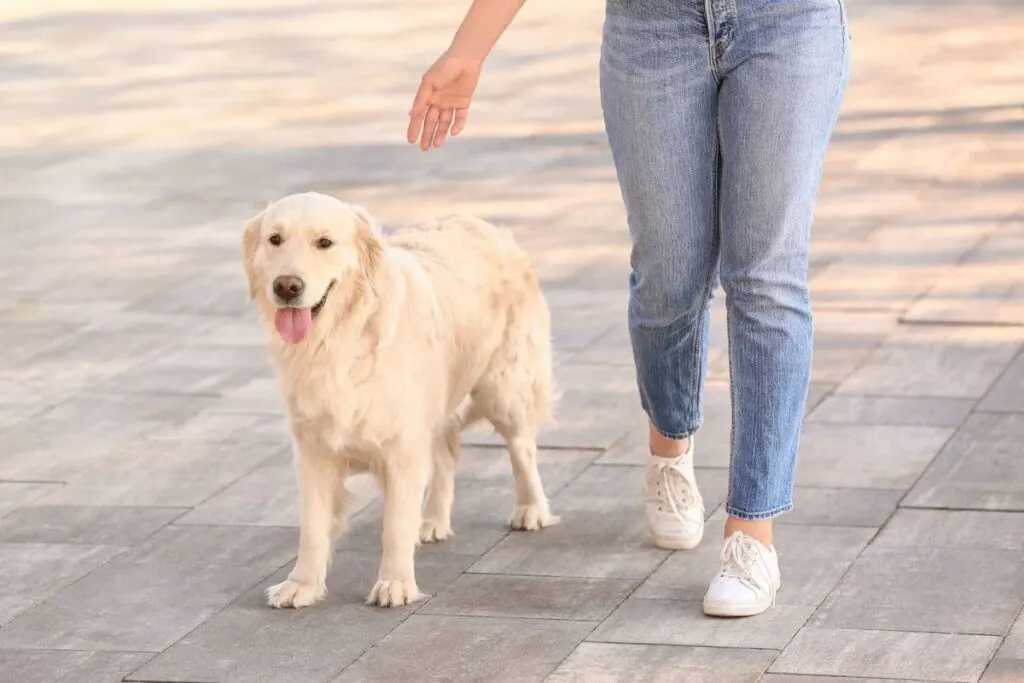
Of course, just as humans are complex creatures and can’t be boxed by a certain temperament or personality, dogs also may be a cross between two different temperaments depending on the situation.
Individual dogs also have their own personality, and the more you know how your dog will react to certain things, the better you will be able to create a strategy that will fit your pet to a tee.
To understand your dog’s temperament, you can:
- Watch how they play. How dogs play with you and other dogs tells a lot about their temperament—do they like to dominate other dogs or are they happy to be the follower instead?
- Observe your dog in unfamiliar environments. What does your dog do when in a new environment or when there are unfamiliar faces around?
- Pay attention to their behavior at home. You will also tell a lot about a dog by how they behave in their comfort zone—does it prefer to play by itself or does it nudge you to play ball with it?
Aside from temperament, there are other factors that affect how a dog behaves and responds to the world around it.
Other things to watch out for or keep in mind are the following:
- History. If you’ve recently adopted a dog from a shelter, it’s important to learn about what its environment and life was like before you got it , as history plays a huge role in how dogs behave.
- Signs of trauma or abuse. One of the most heartbreaking things is seeing a dog cower in fear or one that’s naturally playful turn snappy and aggressive because it has been traumatized by cruel treatment in the past.
- Training or the lack of it. Another thing to consider when adopting a dog is what kind of canine training it has undergone in the past or the total lack of it.
Go at Your Dog’s Pace
If your dog is just not the friendly type and prefers for strangers to leave it alone, then you have to go slowly when training them to accept new people.
Remember that you can’t force your dog to suddenly like having visitors come over just because you want them to.
Respect the pace your dog can tolerate and don’t push them, or else you will only make any reactive behavior, aggression, or fear become much worse.
Here are ways you can make sure that you’re introducing your dog to strangers at a comfortable pace.
Introduce New People in Stages
If your dog has shown aggressive behavior in the past (such as lurching aggressively or biting a visitor), you have to make sure to introduce new people in stages to help your dog learn little by little that new people are okay.
To do this, you can:
- Start with introducing the sound of people coming in. Begin training your dog that the sound of people knocking on the door is okay by giving it treats every time it happens.
- Show new faces, but keep them at a distance for now. Once your dog no longer goes full-on protect mode at the sound of a knock, you can move on to showing visitors but making sure to keep them at a safe distance at this stage.
- Allow people to come close but make no contact. When your dog becomes comfortable with the sight of strangers, you can move on to letting them actually come into the house or move a few meters closer to your pet.
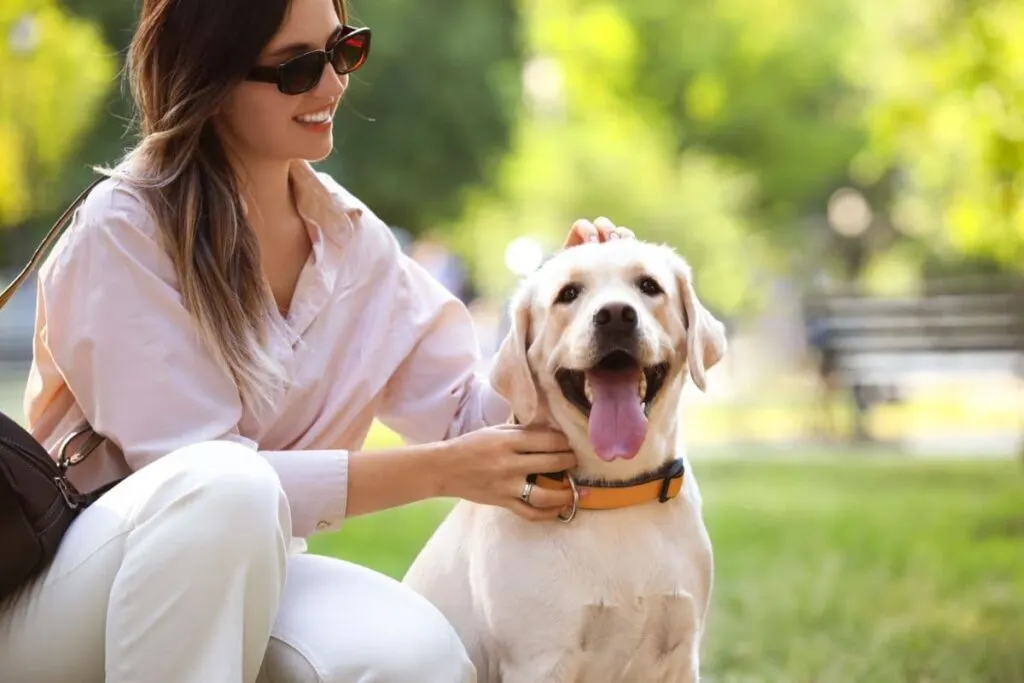
The general rule of thumb when teaching a dog to get used to or accept something is to stop when you notice any signs of discomfort in your dog.
These signs can include:
- Excessive barking
- Lurching forward aggressively or in attack mode
- Biting or attempting to bite
- Growling
- Running away
- Trembling or cowering
Paying attention to your dog’s cues and body language will help you keep the training at a pace that your dog feels comfortable with.
This also ensures that every step of an introduction is kept positive.
Better yet, you can stop just before you know your dog is about to display any aggressive or fearful behavior.
Preventing aggressive behavior even before it appears is a great way to help re-wire your dog’s brain, so to speak, and stops them from establishing unwanted behaviors.
Set Up a Safe Place for Your Pet
When you know that you’re going to have people over, prepare a place for your dog to go to when it feels threatened or scared.
This can be a crate or an area in your home that is baby-gated.
A safe spot is important, especially for fearful dogs, as it provides a place where your dog can feel safe from both the new person and from being overstimulated by their presence.
Remember that fearful or nervous dogs can be aggressive when provoked, so making sure that things do not escalate is a great way to prevent accidents from happening.
A crate or safe spot is also a good way to keep an aggressive dog at a safe distance while it is still undergoing training.
While your dog retreats to this safe spot, you can do the following to help your pet learn that new visitors are okay:
- Act friendly to new people in front of your dog. Dogs can be aggressive to strangers when they’re territorial or highly protective, so to ease these traits a bit, you can show your pet that visitors are welcome.
- Stay calm. Your dog will respond to your energy, whether you say anything or not, so make sure that you don’t act agitated or make a big deal out of a new person coming over to communicate to your dog that it’s no big deal and there’s no need to fuss.
Turn Visitors Into Treat-Bearers
A very effective way to help your dog accept strangers is to turn new people into treat-bearers.
This will help your dog perceive strangers as a source of yummy snacks, so once this gets established in their mind, they will start to anticipate the coming of a house guest as a cue that treats are coming their way.
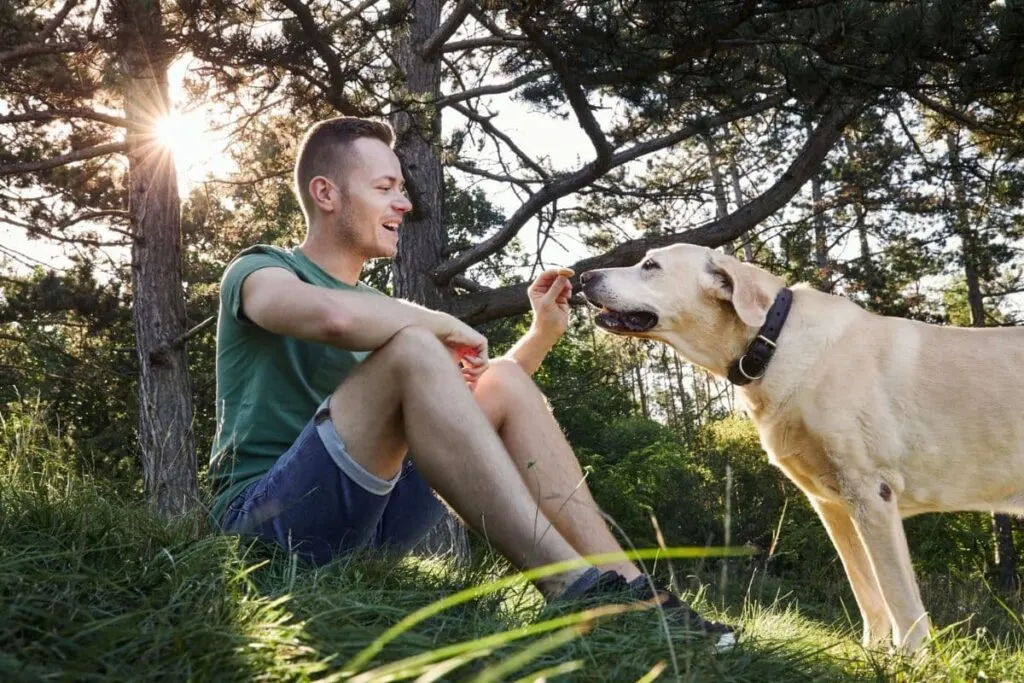
To do this, you can:
- Place treats outside the door for guests to use. Tell house guests that before they knock or come through the door, they have to take a few treats that they can throw to your dog once the door opens.
- Teach guests to keep their distance. Bearing treats does not automatically make people a friend to a dog, so always tell them not to approach the dog (especially one that’s aggressive).
- Let your dog sniff guests out. Dogs greet and size up other dogs and humans by sniffing them, so let your dogs approach guests (instead of the other way around) and decide that they are welcome.
- Have guests hand-feed treats to your dog after a successful greeting. To reinforce the positive greeting, have the visitor hand-feed high-value treats to your dog.
You’ll know when a fearful, aggressive, or shy dog is starting to open up to strangers because their body language will change from tense to loose and comfortable.
Here are signs that your dog is starting to get comfy around strangers:
- Ears are dangling loosely. A happy dog will have ears that hang loosely instead of upright and erect.
- Initiating friendly contact. When a dog is wary of a human being, it will be tentative in its behavior and will not choose to be around the stranger, but as it opens up, it will begin to voluntarily come close without lurching to bite.
- No more barking. When your dog no longer barks non-stop at strangers, you’ll know that it is no longer overstimulated by or afraid of them.
- Relaxing or sleeping. Dogs that are stressed out by the presence of a stranger cannot relax (much less sleep), so if your dog is able to lie down and sleep when there is a new person nearby, you’ll know that it has accepted the visitor.
- Licking new people. Licking is a self-soothing behavior, but it is also a positive sign that a dog likes the object of the licking, so you can relax when your dog starts to lick your guests.
Leash Your Dog When Guests Come
If your dog can’t handle being around other people just yet, make sure to introduce new people while your dog is secured on a leash.
However, give your dog ample time off the leash—in fact, make sure that it is on the leash only when out on walks or when the situation calls for it.
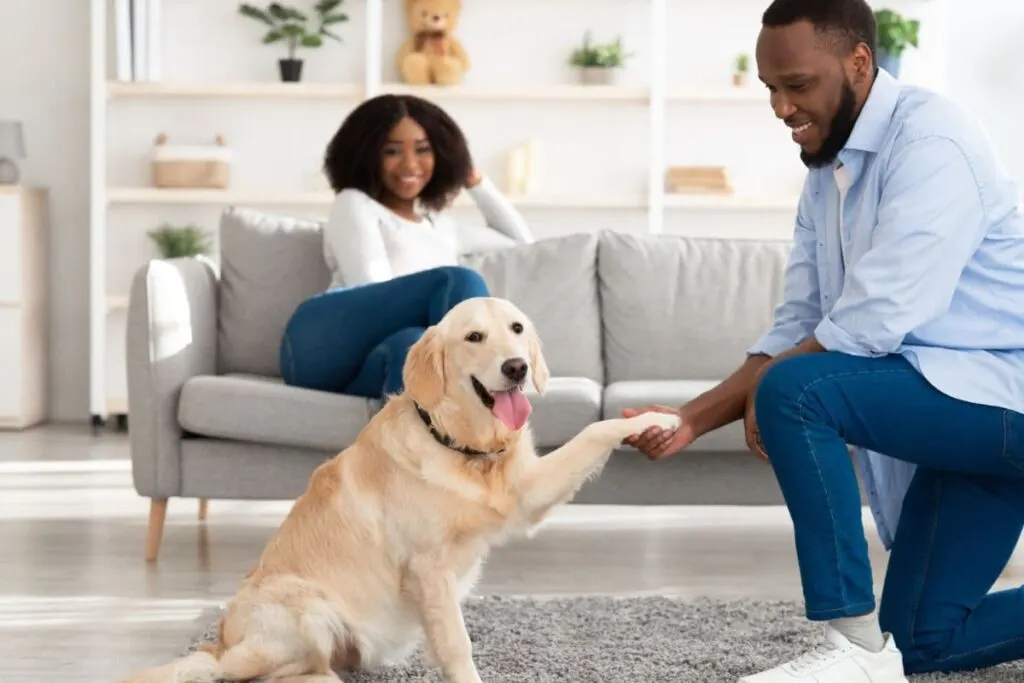
Keeping a dog on a leash, inside a crate, or within a cramped space for extended periods can cause barrier frustration, which results in more aggressive and highly reactive dogs.
I also have an article discussing whether a dog can bond with multiple owners. [Can a Dog Bond With Two Different Owners?]
You should check it out to learn more about socializing your dog and making them comfortable around other people.
Final Thoughts
Dogs are excellent companions, but they also need to be understood as dogs rather than cute, cuddly children if you want them to live happy, fulfilled lives.
Understanding your pet’s natural tendencies and feelings about petting can help you create a strategy that will satisfy both you and your beloved canine.
